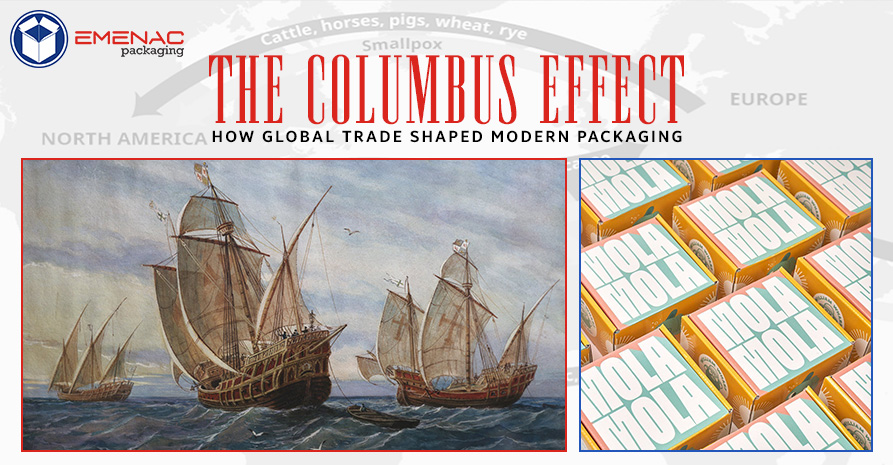
The commencement of Globalization backtracks to the effects of the first expedition of Christopher Columbus that transported him to the coast of an island in the Caribbean Sea, in October of 1492 AD. After this voyage trade began between Europe and the Americas.
Trade contributes to global efficacy. A country opening up trade with another country bestows upon the society a pinnacle of economic prosperity. The foremost function of packaging is to provide fortification and preservation to a product along with aiding in its handling and final appearance, which is the best tool for brands to market products as well.
In this blog, we will go through how goods were packaged in the Columbus Era, how the Industrial Revolution helped make advancements in packaging, and how globalization in trade brought about diversity in the modern packaging industry.
Packaging in the Epoch of Columbus was primarily functional, which means it focused on the protection of goods during long and often hazardous journeys. This packaging was adapted to the types of products being transported keeping in consideration the limitations of the availability of packaging materials available.
Many goods used to be wrapped up in cloth or burlap. This was done to protect items like spices and textiles from moisture and dust during transport.
Crates and barrels of wood were sturdy packaging options, which would be sealed shut to prevent spoilage. These were often used to ship goods in bulk. Grains, fruits, and liquids were often shipped in wooden barrels and crates.
These were used in some cases for effectively preserving the goods during shipments, despite being quite heavy packaging picks. Ceramic and clay pots were a viable option while transporting goods like olives, and oils among other liquids.
In regions of the world, where cloth was scarce, leather and animal hides were used to package goods. Berries, plants, and seeds used to be carried in purses or bags made of hides, and this means of packaging was also used to transfer goods like furs.
As of now, we use packaging tapes, to secure or fasten our packaging, in the Columbus Era, rope and twine were used to hold the goods and their packaging in place, during long and rough cruises!
Note: The materials and methods employed to package goods in Columbus’ time, point towards the limited technology and resources available at the period.
The Industrial Revolution brought about a significant shift from rural to urban life throughout Europe in the mid-1800s. This of course affected the means used to package goods for global trade, as an upgrade from man-made to machine-made came into view.
The end of the nineteenth century saw 3 major revolutions that affected the packaging of items:
It wasn’t until 1867 that paper emanating from wood pulp was invented and it wasn’t until 1798 that Alois Senefelder invented the printing method of lithography. These inventions were a significant breakthrough in the history of packaging design which was progressed by practices of industrial production.
In a progressively co-dependent world, design has advanced radically. Globalization in trade has created considerable diversity in packaging in various ways, some of which we will now discuss:
Global trade has triggered the exchange of goods as well as ideas across boundaries, the result of which is that today, packaging incorporates designs and elements from various cultures throughout the world.
As certain products are produced in one country for the market in another country, the packaging of such products may be adapted to cater to foreign tastes and penchants. This includes packaging sizes, materials, and colors, as well as language translations.
Different countries have varying regulations and labeling requirements for packaged items. It is compulsory for companies involved in worldwide trade to adjust their packaging to comply with the rules and regulations of other countries that have their target market.
Global trade means long-distance shipments which are a logistical challenge in themselves. The packaging needs to be adapted to be sturdy enough to withstand challenges like climatic variations, methods of handling as well as storage requirements, throughout the world.
Earth is a mutual home to all humankind and there is only one like this at least in our solar system. For life to continue on this planet in an advanced manner, it is the global duty of all to contribute to its protection. Therefore, everyone around the globe is switching to eco-friendliness and sustainability in packaging. In this matter, the whole globe has joined hands to put away their differences and prefer sustainable and eco-friendly packaging solutions.
The journey of the advancements in packaging since the time of Columbus’ voyage grew rich and diverse as his travel to the Americas opened gateways to the globalization of trade. Nevertheless, it is good to know that as much as diversity is beautiful in all its forms, globalization has made people realize the importance of sustainable living. Therefore, we are always pleased to provide you with the best options for eco-friendly and sustainable packaging boxes.